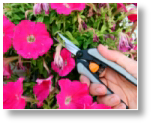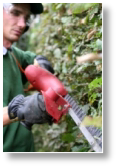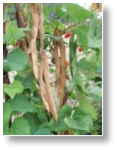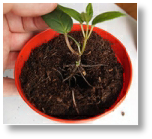


 You do need to keep on top of a few tasks to keep your displays looking good this month. Remove dying and dead flower heads daily. Not only will you remove a potential source of disease, but this will encourage many plants to produce a new flush of flowers. Many summer shrubs and climbers will produce strong new flowering shoots if they are deadheaded. Water baskets and containers daily, even during rain! Water bounces off a leaf canopy, and, even in a downpour, little rain will reach the compost. Water camellias, rhododendrons and azaleas that are in dry locations with stored rain water. Tap water is too limy. A shortage of water at this time of year can cause flower buds to drop, or not even develop properly next spring.
You do need to keep on top of a few tasks to keep your displays looking good this month. Remove dying and dead flower heads daily. Not only will you remove a potential source of disease, but this will encourage many plants to produce a new flush of flowers. Many summer shrubs and climbers will produce strong new flowering shoots if they are deadheaded. Water baskets and containers daily, even during rain! Water bounces off a leaf canopy, and, even in a downpour, little rain will reach the compost. Water camellias, rhododendrons and azaleas that are in dry locations with stored rain water. Tap water is too limy. A shortage of water at this time of year can cause flower buds to drop, or not even develop properly next spring.  To keep evergreen hedges looking good over winter, give them a quick trim now. Over the summer months, Beech (Fagus, pictured), Box (Buxus), Privet (Ligustrum), Laurel (Prunus) and other hedging plants will have put on lots of growth, turning a crisp formal outline into a shaggy eyesore. Using a pair of hand shears or powered hedge trimmers, start by cutting the top of the hedge to a slight pitch (to help dispel snow) and then trim the sides, ensuring that the top is slightly narrower than the base. Use a string attached to canes as a cutting guide or step back regularly to check your progress. After pruning, give the entire hedge line a foliar feed (easiest way is through a hose-
To keep evergreen hedges looking good over winter, give them a quick trim now. Over the summer months, Beech (Fagus, pictured), Box (Buxus), Privet (Ligustrum), Laurel (Prunus) and other hedging plants will have put on lots of growth, turning a crisp formal outline into a shaggy eyesore. Using a pair of hand shears or powered hedge trimmers, start by cutting the top of the hedge to a slight pitch (to help dispel snow) and then trim the sides, ensuring that the top is slightly narrower than the base. Use a string attached to canes as a cutting guide or step back regularly to check your progress. After pruning, give the entire hedge line a foliar feed (easiest way is through a hose-end dilutor with either Miracle- Gro or Phostrogen) to help encourage growth for next season. Keep picking beans, the more you pick, the more you get. Some varieties like 'Borlotti' and many French Beans can be left to dry on the plant and the seeds saved to eat as pulses in winter stews. British Runner Bean seeds can be a bit tough and sometimes they don't soften and cook as well as their foreign cousins, but it is well worth giving them a try. Finally, save some seeds for next year, store in a cool dry place and they will romp away when you sow them early in the New Year. There is still time to plant Cabbage, Salad Leaves, early Peas and Cauliflower, but plug plants are limited, so if you have gaps to fill, don't delay!
Keep picking beans, the more you pick, the more you get. Some varieties like 'Borlotti' and many French Beans can be left to dry on the plant and the seeds saved to eat as pulses in winter stews. British Runner Bean seeds can be a bit tough and sometimes they don't soften and cook as well as their foreign cousins, but it is well worth giving them a try. Finally, save some seeds for next year, store in a cool dry place and they will romp away when you sow them early in the New Year. There is still time to plant Cabbage, Salad Leaves, early Peas and Cauliflower, but plug plants are limited, so if you have gaps to fill, don't delay! - There are plenty of perennials, herbs and shrubs that can be propagated from this month. These so-
called 'semi- ripe cuttings' can be taken from a wide range of plants, including Berberis, Fuchsias , Hebes, Lavenders, Penstemons, Vincas, Kitchen Bay (Laurus nobilis), Sages, Thymes and even Ceanothus. Here's the process... Take a strong, non- flowering shoot about 5in (12cm) long. Remove the lower leaves, trim to just below a leaf joint. Insert into a pot containing a peat- free, multipurpose compost.  Cover with a milky-
Cover with a milky-white plastic bag (like the one you get with your dry cleaning) supported with a bent wire frame to prevent the cutting touching the sides and rotting. Place the pot out of direct sunlight. Once rooting has taken place after 3- 4 weeks, harden off gradually to acclimatise to reduced humidity and increased light. Pot up the cuttings into a 3½ inch pots using gritty peat- free, multipurpose compost.



Featured on our web shop:












Visit our questions page here

Would you like to subscribe to our newsletters about Garden Centre News, offers and events?













BUCKINGHAM NURSERIES AND GARDEN CENTRE, Tingewick Road, Buckingham, MK18 4AE
Tel: 01280 822133 Fax: 01280 815491 E-







GARDEN CENTRE: Mon -


